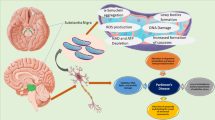Abstract
Hypocretin/Orexin (Hcrt/Orx) neurons of the posterolateral hypothalamus have been implicated in control of sleep and autonomic function. Sleep disorders and autonomic failure are important manifestations of multiple system atrophy (MSA). We sought to determine whether Hcrt/Orx neurons were involved in this disorder. Hypothalamus was obtained from seven subjects with neuropathologically confirmed MSA, and seven age-matched controls. 50 μm sections obtained throughout the posterior hypothalamus were immunostained for Hcrt-1 and α-synuclein. In MSA, there was a marked reduction of the total numbers of Hcrt/Orx neurons compared to controls (1,009 ± 190 cells in MSA vs. 3,206 ± 185 in controls, P < 0.0001). There were abundant glial cytoplasmic inclusions in the area of distribution of Hcrt/Orx neurons in MSA. This is the first demonstration of loss of Hcrt/Orx neurons in MSA, which is consistent with a system degeneration of neurons involved in homeostatic function, including sleep and autonomic regulation, in this disorder.



Similar content being viewed by others
References
Arnulf I (2005) Excessive daytime sleepiness in Parkinsonism. Sleep Med Rev 9:185–200
Baumann CR, Bassetti CL (2005) Hypocretins (orexins) and sleep-wake disorders. Lancet Neurol 4:673–682
Baumann CR, Dauvilliers Y, Mignot E, Bassetti CL (2004) Normal CSF hypocretin-1 (orexin A) levels in dementia with Lewy bodies associated with excessive daytime sleepiness. Eur Neurol 52:73–76
Berthoud HR, Patterson LM, Sutton GM, Morrison C, Zheng H (2005) Orexin inputs to caudal raphe neurons involved in thermal, cardiovascular, and gastrointestinal regulation. Histochem Cell Biol 123(2):147–156
Crocker A, Espana RA, Papadopoulou M, Saper CB, Faraco J, Sakurai T, Honda M, Mignot E, Scammell TE (2005) Concomitant loss of dynorphin, NARP, and orexin in narcolepsy. Neurology 65:1184–1188
de Lecea L, Sutcliffe JG (2005) The hypocretins and sleep. FEBS J 272:5675–5688
de Oliveira CV, Ciriello J (2003) Cardiovascular responses to hypocretin-1 in nucleus ambiguus of the ovariectomized female rat. Brain Res 986:148–156
de Oliveira CV, Rosas-Arellano MP, Solano-Flores LP, Ciriello J (2003) Cardiovascular effects of hypocretin-1 in nucleus of the solitary tract. Am J Physiol Heart Circ Physiol 284:H1369–H1377
Dun NJ, Le Dun S, Chen CT, Hwang LL, Kwok EH, Chang JK (2000) Orexins: a role in medullary sympathetic outflow. Regul Pept 96:65–70
Ghorayeb I, Bioulac B, Tison F (2005) Sleep disorders in multiple system atrophy. J Neural Transm 112:1669–1675
Gilman S, Low PA, Quinn N, Albanese A, Ben-Shlomo Y, Fowler CJ, Kaufmann H, Klockgether T, Lang AE, Lantos PL, Litvan I, Mathias CJ, Oliver E, Robertson D, Schatz I, Wenning GK (1999) Consensus statement on the diagnosis of multiple system atrophy. J Neurol Sci 163:94–98
Hogl B, Seppi K, Brandauer E, Wenning G, Poewe W (2001) Irresistible onset of sleep during acute levodopa challenge in a patient with multiple system atrophy (MSA): placebo-controlled, polysomnographic case report. Mov Disord 16:1177–1179
Kayaba Y, Nakamura A, Kasuya Y, Ohuchi T, Yanagisawa M, Komuro I, Fukuda Y, Kuwaki T (2003) Attenuated defense response and low basal blood pressure in orexin knockout mice. Am J Physiol Regul Integr Comp Physiol 285:R581–R593
Kukkonen JP, Holmqvist T, Ammoun S, Akerman KE (2002) Functions of the orexinergic/hypocretinergic system. Am J Physiol Cell Physiol 283:C1567–1591
Lu J, Devor M, Saper CB (2006) A putative flip-flop I switch for control of REM sleep. Nature 441:589–594
Lu J, Jhou TC, Saper CB (2006) Identification of wake-active dopaminergic neurons in the ventral periaqueductal gray matter. J Neurosci 26:193–202
Nakamura S, Ohnishi K, Nishimura M, Suenaga T, Akiguchi I, Kimura J, Kimura T (1996) Large neurons in the tuberomammillary nucleus in patients with Parkinson’s disease and multiple system atrophy. Neurology 46:1693–1696
Overeem S, van Hilten JJ, Ripley B, Mignot E, Nishino S, Lammers GJ (2002) Normal hypocretin-1 levels in Parkinson’s disease patients with excessive daytime sleepiness. Neurology 58:498–499
Ozawa T, Oyanagi K, Tanaka H, Horikawa Y, Takahashi H, Morita T, Tsuji S (1998) Suprachiasmatic nucleus in a patient with multiple system atrophy with abnormal circadian rhythm of arginine–vasopressin secretion into plasma. J Neurol Sci 154:116–121
Sachs C, Kaijser L (1982) Autonomic regulation of cardiopulmonary functions in sleep apnea syndrome and narcolepsy. Sleep 5:227–238
Sakurai T, Amemiya A, Ishii M, Matsuzaki I, Chemelli RM, Tanaka H, Williams SC, Richardson JA, Kozlowski GP, Wilson S, Arch JR, Buckingham RE, Haynes AC, Carr SA, Annan RS, McNulty DE, Liu WS, Terrett JA, Elshourbagy NA, Bergsma DJ, Yanagisawa M (1998) Orexins and orexin receptors: a family of hypothalamic neuropeptides and G protein-coupled receptors that regulate feeding behavior. Cell 92:573–585
Samson WK, Taylor MM, Ferguson AV (2005) Non-sleep effects of hypocretin/orexin. Sleep Med Rev 9:243–252
Saper CB, Chou TC, Scammell TE (2001) The sleep switch: hypothalamic control of sleep and wakefulness. Trends Neurosci 24:726–731
Thannickal TC, Moore RY, Nienhuis R, Ramanathan L, Gulyani S, Aldrich M, Cornford M, Siegel JM (2000) Reduced number of hypocretin neurons in human narcolepsy. Neuron 27:469–474
van den Top M, Nolan MF, Lee K, Richardson PJ, Buijs RM, Davies CH, Spanswick D (2003) Orexins induce increased excitability and synchronisation of rat sympathetic preganglionic neurones. J Physiol 549:809–821
Vetrugno R, Provini F, Cortelli P, Plazzi G, Lotti EM, Pierangeli G, Canali C, Montagna P (2004) Sleep disorders in multiple system atrophy: a correlative video–polysomnographic study. Sleep Med 5:21–30
Wenning GK, Colosimo C, Geser F, Poewe W (2004) Multiple system atrophy. Lancet Neurol 3:93–103
Young JK, Wu M, Manaye KF, Kc P, Allard JS, Mack SO, Haxhiu MA (2005) Orexin stimulates breathing via medullary and spinal pathways. J Appl Physiol 98:1387–1395
Acknowledgments
This study was supported by a grant from the National Institutes of Health (NS32352-P2) and Mayo Funds.
Author information
Authors and Affiliations
Corresponding author
Rights and permissions
About this article
Cite this article
Benarroch, E.E., Schmeichel, A.M., Sandroni, P. et al. Involvement of hypocretin neurons in multiple system atrophy. Acta Neuropathol 113, 75–80 (2007). https://doi.org/10.1007/s00401-006-0150-0
Received:
Revised:
Accepted:
Published:
Issue Date:
DOI: https://doi.org/10.1007/s00401-006-0150-0




